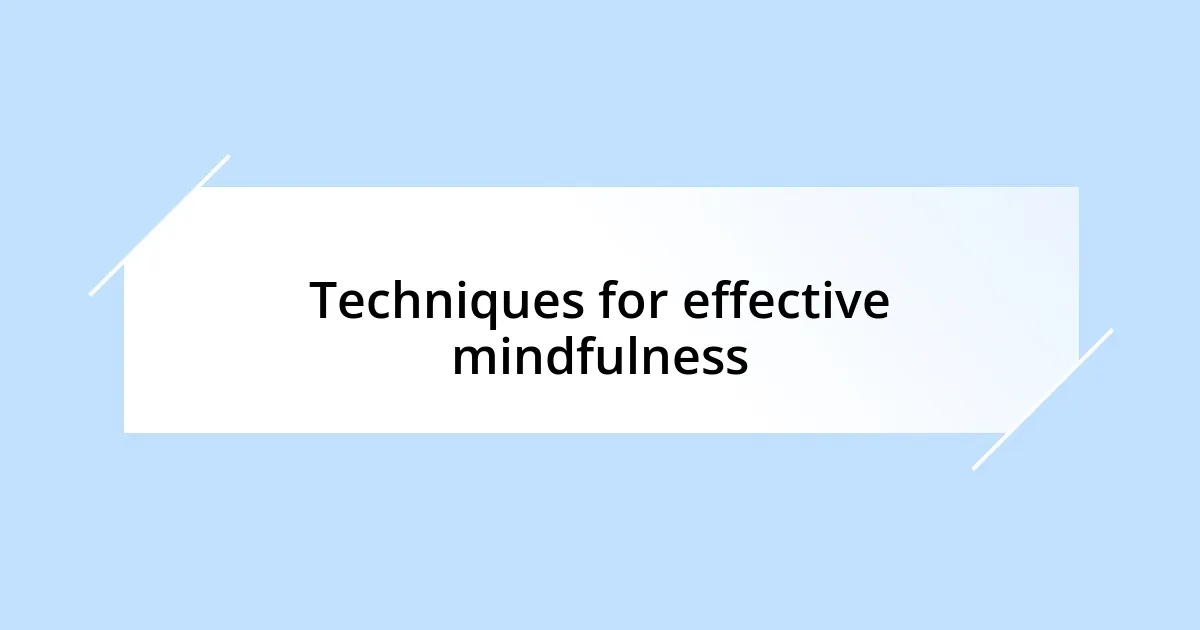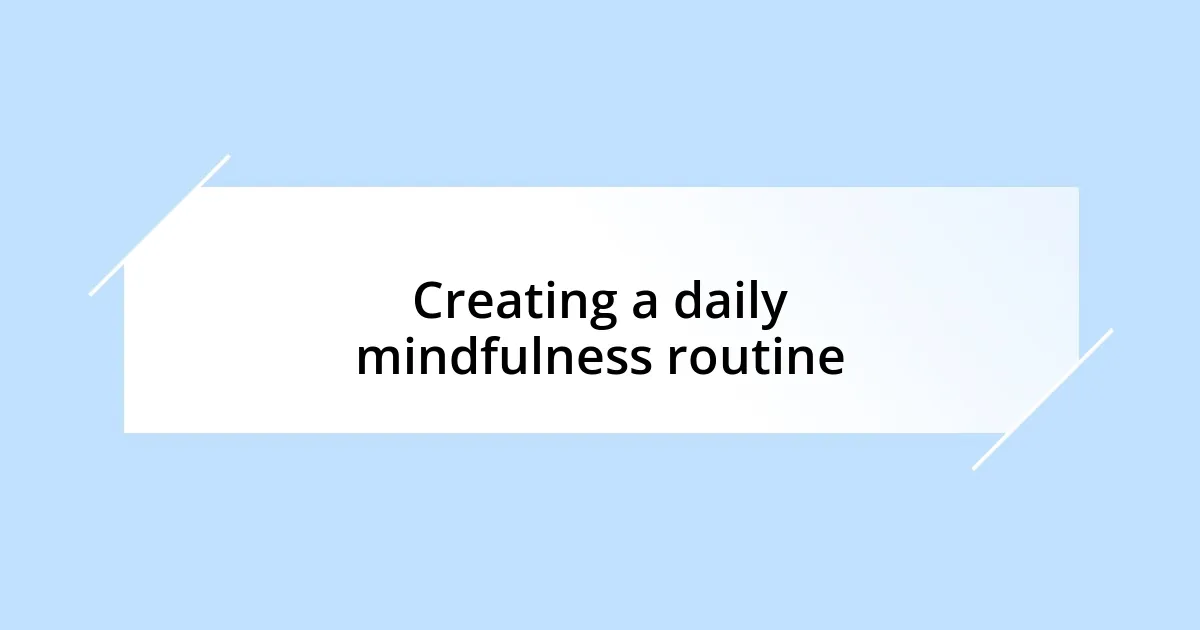Key takeaways:
- Daily mindfulness practices enhance awareness, emotional regulation, and stress reduction, transforming routine experiences into profound moments.
- Incorporating techniques like mindful breathing, body scanning, and journaling can deepen mindfulness and facilitate emotional processing.
- Creating a consistent mindfulness routine, even for short durations, reinforces the practice and helps navigate challenges with self-compassion.
- Measuring progress through journaling and setting intentional goals highlights the benefits of mindfulness in improving mood and stress management.

Understanding daily mindfulness practices
Daily mindfulness practices are all about bringing our attention back to the moment we’re living in. I remember the first time I sat down for a mindful breathing session; it felt strange to focus solely on my breath, yet it was fascinating how the world around me faded away. Have you ever noticed how busy our minds can get, drifting from one thought to another? At that moment, I realized that mindfulness wasn’t just a practice but a way to reclaim our peace.
Incorporating mindfulness into my daily routine transformed mundane moments into opportunities for reflection. For instance, during my morning coffee, I began to savor each sip, recognizing the warmth of the cup and the aroma. This simple act made me more aware of my surroundings and allowed me to appreciate little things I often overlooked. It’s amazing how something as routine as drinking coffee can become such a profound experience, don’t you think?
I’ve found that daily mindfulness isn’t just about quieting the mind; it’s also about embracing our emotions. One day, I felt an overwhelming wave of anxiety while practicing and instead of resisting it, I acknowledged it. I wondered, what if I could simply sit with this feeling? That moment taught me that accepting our feelings, rather than pushing them away, can lead to greater understanding and ultimately, more joy.

Benefits of practicing mindfulness
Practicing mindfulness can lead to profound benefits in our daily lives. I’ve experienced a noticeable reduction in stress levels since I began these practices. It’s as if my mind has traded in chaos for clarity. When those stressful moments arise, I find myself better equipped to handle them. The more I practice, the easier it becomes to navigate challenges. Here’s a look at some benefits I’ve encountered:
- Enhanced emotional regulation: Mindfulness helps me respond to emotions rather than react impulsively.
- Improved focus and concentration: I can hone in on tasks without getting easily distracted.
- Deeper connection with myself and others: Being present has strengthened my relationships as I listen more attentively.
Another benefit I’ve found is a greater sense of well-being. When I committed to including mindfulness in my routine, I discovered a remarkable increase in overall happiness. I remember one afternoon, sitting on my porch, closing my eyes, and simply listening to the rustling leaves and birds chirping. At that moment, a wave of gratitude washed over me. It’s incredible how these moments of pure presence can shift our entire perspective. Mindfulness encourages a more positive mindset, allowing us to appreciate life just as it is.

Techniques for effective mindfulness
Effective mindfulness techniques can take many forms, and I’ve found that discovering what resonates with me has been key to maintaining my practice. For example, when I started incorporating body scans into my routine, I was surprised at how much tension I held in my shoulders. By consciously bringing awareness to each part of my body, I not only learned to relax but also gained a deeper appreciation for how my body responds to stress. Have you ever taken a moment to just breathe deeply, focusing on each inhale and exhale? It can be incredibly grounding.
One technique that truly captivated me was mindful walking. Initially, I felt awkward walking slowly, focusing entirely on each step, but then I discovered the rhythm of my feet touching the ground. It was such a revelation, as I started to notice the sounds of nature and the feeling of the breeze against my skin. It made me reflect on how often I rush through life without truly experiencing the world around me. This gentle pace helped me cultivate a connection with my surroundings, enhancing my mindfulness journey.
In my experience, journaling also serves as an excellent mindfulness tool. Writing down my thoughts each evening allows me to process the day’s events and emotions. I recall one night where I poured my heart out about a recent setback, and in reflecting on it, I found clarity I hadn’t realized I needed. That simple act transformed my anxiety into understanding. What methods have you found help you stay present? It’s interesting to explore how different techniques work uniquely for each of us.
| Technique | Benefits |
|---|---|
| Mindful Breathing | Helps focus the mind, reduces anxiety, and promotes relaxation. |
| Body Scanning | Enhances awareness of physical sensations, helping to release tension. |
| Mindful Walking | Connects with nature, promotes grounding, and encourages presence. |
| Journaling | Facilitates emotional processing and clarity of thoughts. |

Creating a daily mindfulness routine
Establishing a daily mindfulness routine has been a game-changer for me. I started small by dedicating just five minutes each morning to sit quietly with my thoughts. Gradually, as I felt the positive impact on my mindset, I extended this time to fifteen minutes before diving into my day. That early quietude feels like a gentle nudge to my mind, preparing me for whatever comes my way.
One day, while trying to create my routine, I was struck by the challenge of maintaining consistency. I found that treating mindfulness like an appointment on my calendar helped immensely. By marking it down, I committed to those minutes just as I would for any other important meeting. Have you ever tried blocking out time just for yourself? This simple act can be transformative, turning fleeting moments into a cherished ritual that anchors my day.
On days when I feel overwhelmed, I remind myself that mindfulness isn’t about perfection; it’s about presence. I recall an afternoon filled with chaos and how pausing to take a few deep breaths helped clear my mind. Yes, I’ve had days where distractions pull me away, but I’ve learned that it’s okay to start again, even multiple times a day. What has your experience been with creating a routine? Finding what resonates personally is key to making mindfulness a lasting part of our lives.

Overcoming challenges in mindfulness
Overcoming challenges in mindfulness can be a daunting journey, especially when distractions and busy thoughts invade my quiet moments. I remember one particularly hectic day when I attempted to meditate but found myself endlessly replaying my to-do list. Instead of getting frustrated, I decided to accept those thoughts without judgment. This shift allowed me to return my focus to my breath, reminding me that it’s perfectly normal to have off days. Have you felt that sense of distraction too? It’s part of the process.
On those days when mindfulness feels more like a struggle than a practice, I tap into the power of self-compassion. I’ve learned to treat myself kindly, understanding that growth takes time. For instance, there was a period when I missed my morning sessions multiple times in a week. Instead of berating myself, I acknowledged my feelings and started fresh with a brief five-minute session. Each time I reset my intentions, I felt a weight lift off my shoulders, promoting a gentle return to practice.
One insight that has been vital in overcoming challenges is recognizing that mindfulness is not about escaping my thoughts but about embracing them. I recall sitting in a park, intending to enjoy a moment of stillness, but my mind began to spiral into worries about future deadlines. Instead of resisting, I chose to explore those worries with curiosity. What triggered them? How did they make me feel? This exploration turned into an enlightening experience, deepening my understanding of myself. Isn’t it fascinating how challenges can lead to new insights?

Measuring mindfulness progress
Measuring mindfulness progress often requires a blend of subjective reflection and objective markers. I often jot down my feelings in a journal after each session, noting any changes in my mood or level of anxiety. Have you tried keeping a mindfulness journal? I find that this practice not only helps track my progress but also allows me to observe patterns over time, revealing how even small moments of mindful awareness can create noticeable shifts in my emotional landscape.
One effective method I’ve embraced is setting intentional monthly goals. For instance, I challenged myself to engage in mindfulness practices outside of my routine, like mindful eating or walking. Tracking those experiences has been enlightening; I noticed that my enjoyment of simple things increased, and I became more present throughout my day. Can you recall a time when being mindful transformed a mundane task into something meaningful? By focusing on these intentional goals, I’ve been able to see the tangible benefits and growth in my daily life.
Another measurement is my ability to handle stress. I used to crumble under pressure, but I’ve noticed a significant change lately. When faced with a difficult situation, instead of reacting impulsively, I pause to breathe. This shift doesn’t always happen perfectly, but even occasional awareness has led to improved reactions. What has been your experience with stress and mindfulness? Reflecting on days when I felt calm in chaos reassures me that I’m making strides. Progress isn’t always linear; it’s essential to celebrate those small victories along the way.

Integrating mindfulness into daily life
Finding ways to weave mindfulness into my daily routines has been transformative. One of my favorite practices is taking a few moments to engage my senses while I’m making my morning coffee. The aroma, the warmth of the mug, the feel of the ground coffee—it all draws me into the present. By slowing down and savoring that simple act, I find that my hectic day starts off with a sense of calm and clarity. Have you thought about how you can incorporate mindfulness into your own daily rituals?
I’ve also discovered the power of transitions. For example, when I switch from work mode to family time, I take a moment to sit quietly and breathe deeply before diving into my evening routine. This brief pause acts as a reset button, helping me shed the day’s stresses and be more present with my loved ones. It’s amazing how a tiny ritual can shift my mindset. Have you tried creating small mindful moments in your transitions?
Another technique I use is mindful walking. During my lunch breaks, I step outside and consciously feel each step on the ground and the rhythm of my breath. Just last week, I noticed a beautiful tree along my route, one I had overlooked for months. It felt as if that moment of awareness was a gift, deepening my connection to my surroundings. Doesn’t it feel good to slow down and truly see the world? These practices, however small, remind me of the beauty in the mundane and help maintain my mindfulness journey throughout the day.














